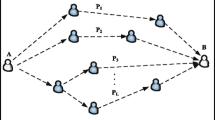Abstract
In opportunistic networks (OppNets), instead of assuming a complete path, messages are exchanged opportunistically when two nodes encounter. To support efficient and reliable end-to-end messaging in OppNets, a number of routing protocols based on network coding have been proposed. However, few efforts in the studies focus on opportunistic network coding (ONC). It is because the coding opportunities do not probably exist in OppNets due to nodal mobility, low density, lossy link, etc. In this paper, an ONC routing model for OppNets based on a new hybrid communication scheme was proposed. The communication scheme combines contact-based communication mode used by most routing protocols in OppNets and contact duration-based communication mode employed by few routing protocols in OppNets. We also designed an ONC routing protocol based on the ONC routing model in OppNets. Simulated results show that compared with Epidemic routing, the ONC routing can achieve higher delivery ratio and lower delay but consume fewer network cost.











Similar content being viewed by others
References
Pelusi, L., Passarella, A., Conti, M.: Opportunistic networking: data forwarding in disconnected mobile ad hoc networks. IEEE Commun. Mag. 44, 1–4 (2006)
Boldrini, C., Lee, K., Onen, M., et al.: Opportunistic networks. Comput. Commun. 48, 1–4 (2014)
Mota, V.F.S., et al.: Protocols, mobility models and tools in opportunistic networks: a survey. Comput. Commun. 48, 5–19 (2014)
Katti, S., Rahul, H., Hu, W.J., et al.: XORs in the air: practical wireless network coding. IEEE-ACM Trans. Netw. 16, 497–510 (2008)
Sengupta, S., Rayanchu, S., Banerjee, S.: Network coding-aware routing in wireless networks. IEEE-ACM Trans. Netw. 18, 1158–1170 (2010)
Khreishah, A., Khalil, I.M., Wu, J.: Distributed network coding-based opportunistic routing for multicast. MobiHoc 12, 115–124 (2012)
Amerimehr, M.H., Ashtiani, F.: Delay and throughput analysis of a two-way opportunistic network coding-based relay network. IEEE Trans. Wirel. Commun. 13, 2863–2873 (2014)
Chachulski, S., et al.: Trading structure for randomness in wireless opportunistic routing. ACM SIGCOMM Comput. Commun. Rev. 37, 169–180 (2007)
Iqbal, M.A., Dai, B., Huang, B., Hassan, A., Yu, S.: Survey of network coding-aware routing protocols in wireless networks. J. Netw. Comput. Appl. 34, 1956–1970 (2011)
Widmer, J., Le Boudec, J.Y.: Network coding for efficient communication in extreme networks. In: SIGCOMM’05 (WDTN). ACM, New York, pp. 284–291 (2005)
Yunfeng, L., Baochun, L., Ben, L. : Efficient network coded data transmissions in disruption tolerant networks. In: ICC’08, IEEE (2008)
Zeng, D.Z., Guo, S., Jin, H. et al.: Dynamic segmented network coding for reliable data dissemination in delay tolerant networks. In: ICC’12, New York, pp. 63–67 (2012)
Xiaolan, Z., Neglia, G., Kurose, J., et al.: Benefits of network coding for unicast application in disruption-tolerant networks. IEEE/ACM Trans. Netw. 21, 1407–1420 (2013)
Ali, A., Panda, M., Chahed, T., Altman, E.: Improving the transport performance in delay tolerant networks by random linear network coding and global acknowledgments. Ad Hoc Netw. 11, 2567–2587 (2013)
Hassanabadi, B., Valaee, S.: Reliable periodic safety message broadcasting in VANETs using network coding. IEEE Trans. Wirel. Commun. 13, 1284–1297 (2014)
Eagle, Nathan, Pentland, Alex S.: Reality mining: sensing complex social systems. Pers. Ubiquitous Comput. 10, 255–268 (2006)
Pan, H., Augustin, C., James, S. et al.: Pocket switched networks and human mobility in conference environments. In: SIGCOMM’05 (WDTN), pp. 244–251 (2005)
Vahdat, A., Becker, D.: Epidemic Routing for Partially Connected Ad Hoc Networks. Technical Report, CS-200006 (2000)
Mueller, K.: SimPy. https://simpy.readthedocs.org/en/latest/index.html
Acknowledgments
This paper is supported by the National Natural Science Fund of China under Grant Nos. 61170241 and 61472097, the Research Fund for the Scientific Items of Jilin Provincial Department of Education No. 2013207, and this paper is also funded by the International Exchange Program of Harbin Engineering University for Innovation-oriented Talents Cultivation.
Author information
Authors and Affiliations
Corresponding authors
Rights and permissions
About this article
Cite this article
Yao, J., Ma, C., Wu, P. et al. An Opportunistic Network Coding Routing for Opportunistic Networks. Int J Parallel Prog 45, 157–171 (2017). https://doi.org/10.1007/s10766-015-0392-3
Received:
Accepted:
Published:
Issue Date:
DOI: https://doi.org/10.1007/s10766-015-0392-3




